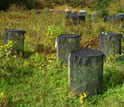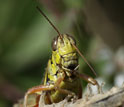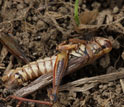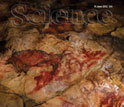News Release 12-113
Predators Have Outsized Influence Over Habitats
Study of grasshoppers' diets shows that animals are an important part of organic matter decomposition
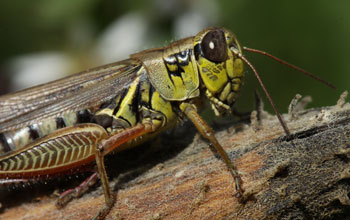
Grasshoppers' diets while being hunted may affect how soil releases carbon dioxide.
June 14, 2012
This material is available primarily for archival purposes. Telephone numbers or other contact information may be out of date; please see current contact information at media contacts.
A grasshopper's change in diet to high-energy carbohydrates while being hunted by spiders may affect the way soil releases carbon dioxide into the atmosphere, according to research results published this week in the journal Science.
Grasshoppers like to munch on nitrogen-rich grass because it stimulates their growth and reproduction.
But when spiders enter the picture, grasshoppers cope with the stress from fear of predation by shifting to carbohydrate-rich plants, setting in motion dynamic changes to the ecosystem they inhabit, scientists have found.
"Under stressful conditions they go to different parts of the 'grocery store' and choose different foods, changing the makeup of the plant community," said Oswald Schmitz, a co-author of the paper and an ecologist at Yale University.
The high-energy, carbohydrate diet also tilts a grasshopper's body chemistry toward carbon at the expense of nitrogen.
So when a grasshopper dies, its carcass breaks down more slowly, thus depriving the soil of high-quality fertilizer and slowing the decomposition of uneaten plants.
"This study casts a new light on the importance of predation in natural communities," said Saran Twombly, program director in the National Science Foundation's Division of Environmental Biology, which funded the research.
"A clever suite of experiments shows that the dark hand of predation extends all the way from altering what prey eat to the nutrients their decomposing bodies contribute to soil."
Microbes in the soil require a lot of nitrogen to function and to produce the enzymes that break down organic matter.
"It only takes a slight change in the chemical composition of that animal biomass to fundamentally alter how much carbon dioxide the microbial pool is releasing to the atmosphere while it is decomposing plant organic matter," said Schmitz.
"This shows that animals could potentially have huge effects on the global carbon balance because they're changing the way microbes respire organic matter."
The researchers found that the rate at which the organic matter of leaves decomposed increased between 60 percent and 200 percent in stress-free conditions relative to stressed conditions, which they consider "huge."
"Climate and litter quality are considered the main controls on organic-matter decomposition, but we show that aboveground predators change how soil microbes break down organic matter," said Mark Bradford, a co-author of the study and also an ecologist at Yale.
Schmitz added: "What it means is that we're not paying enough attention to the control that animals have over what we view as a classically important process in ecosystem functioning."
The researchers took soil from the field, put it in test tubes and ground up grasshopper carcasses obtained from environments either with or without grasshopper predators.
They then sprinkled the powder atop the soil, where the microbes digested it.
When the grasshopper carcasses were completely decomposed, the researchers added leaf litter and measured the rate of leaf-litter decomposition.
The experiment was then replicated in the field at the Yale Myers Forest in northeastern Connecticut.
"It was a two-stage process where the grasshoppers were used to prime the soil, then we measured the consequences of that priming," said Schmitz.
The effect of animals on ecosystems is disproportionately larger than their biomass would suggest.
"Traditionally people thought that animals had no important role in recycling of organic matter, because their biomass is relatively small compared to the plant material that's entering ecosystems," Schmitz said.
"We need to pay more attention to the role of animals, however. In an era of biodiversity loss we're losing many top predators and larger herbivores from ecosystems."
Other co-authors are Michael Strickland of Yale, and Dror Hawlena of the Hebrew University of Jerusalem.
-NSF-
-
Field experiments underway at the Yale Myers forest research site.
Credit and Larger Version -
Coping with stress from fear of predation leads to a shift in grasshopper food choices.
Credit and Larger Version -
Scientists take measurements of carbon dioxide during field experiments.
Credit and Larger Version -
Grasshopper decomposition is important to biologists studying predator-prey relationships.
Credit and Larger Version -
Experiments continue in the laboratory, here measuring soil respiration.
Credit and Larger Version -
The researchers' work is described in the June 15, 2012 issue of the journal Science.
Credit and Larger Version
Media Contacts
Cheryl Dybas, NSF, (703) 292-7734, email: cdybas@nsf.gov
Dave DeFusco, Yale University, (203) 436-4842, email: david.defusco@yale.edu
The U.S. National Science Foundation propels the nation forward by advancing fundamental research in all fields of science and engineering. NSF supports research and people by providing facilities, instruments and funding to support their ingenuity and sustain the U.S. as a global leader in research and innovation. With a fiscal year 2023 budget of $9.5 billion, NSF funds reach all 50 states through grants to nearly 2,000 colleges, universities and institutions. Each year, NSF receives more than 40,000 competitive proposals and makes about 11,000 new awards. Those awards include support for cooperative research with industry, Arctic and Antarctic research and operations, and U.S. participation in international scientific efforts.
Connect with us online
NSF website: nsf.gov
NSF News: nsf.gov/news
For News Media: nsf.gov/news/newsroom
Statistics: nsf.gov/statistics/
Awards database: nsf.gov/awardsearch/
Follow us on social
Twitter: twitter.com/NSF
Facebook: facebook.com/US.NSF
Instagram: instagram.com/nsfgov



